Panasonic s-07mk2u6, s-09mk2u6, s-12mk2u6 installation

INSTALLATION INSTRUCTIONS
– VRF System Air Conditioner –
This air conditioner uses the refrigerant R410A.
Model No.
|
Indoor Units |
|
|
|
|
|
|
|
|
|
|
Type |
Indoor Unit Type |
|
Nominal Capacity |
|
|
|
|
|
|||
7 |
9 |
12 |
|||
|
|
||||
|
|
|
|
|
|
K2 |
Wall Mounted |
S-07MK2U6 |
S-09MK2U6 |
S-12MK2U6 |
|
|
|
|
|
|
Read through the Installation Instructions before you proceed with the installation.
In particular, you will need to read under the “IMPORTANT!” section at the top of the page.
F616470
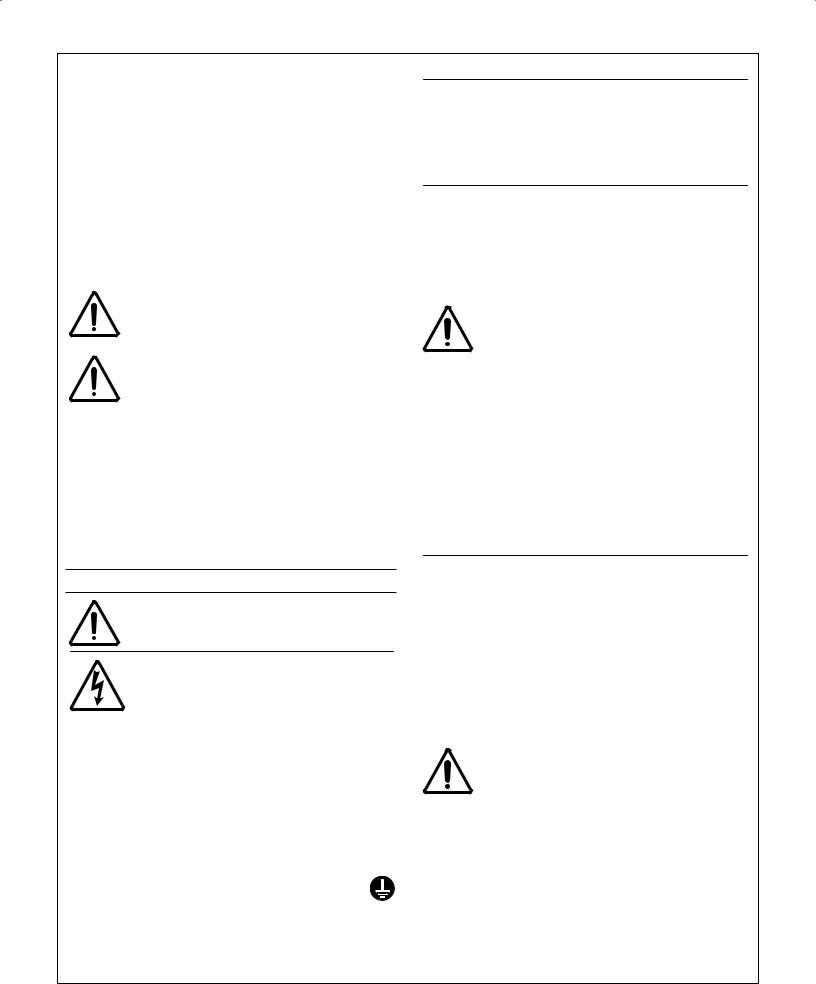
IMPORTANT!
Please Read Before Starting
This air conditioning system meets strict safety and operating standards. As the installer or service person, it is an important part of your job to install or service the system so it operates safely and efficiently.
For safe installation and trouble-free operation, you must:
●Carefully read this instruction booklet before beginning.
●Follow each installation or repair step exactly as shown.
●This air conditioner shall be installed in accordance with National Wiring Regulations.
●Pay close attention to all warning and caution notices given in this manual.
This symbol refers to a hazard
WARNING or unsafe practice which can result in severe personal
injury or death.
This symbol refers to a hazard
CAUTION or unsafe practice which can result in personal injury or
product or property damage.
If Necessary, Get Help
These instructions are all you need for most installation sites and maintenance conditions. If you require help for a special problem, contact our sales/service outlet or your certified dealer for additional instructions.
In Case of Improper Installation
The manufacturer shall in no way be responsible for improper installation or maintenance service, including failure to follow the instructions in this document.
SPECIAL PRECAUTIONS
WARNING When Wiring
ELECTRICAL SHOCK CAN CAUSE
SEVERE PERSONAL INJURY OR
DEATH. ONLY A QUALIFIED,
EXPERIENCED ELECTRICIAN SHOULD
ATTEMPT TO WIRE THIS SYSTEM.
•Do not supply power to the unit until all wiring and tubing are completed or reconnected and checked.
•Highly dangerous electrical voltages are used in this system. Carefully refer to the wiring diagram and these instructions when wiring. Improper connections and inadequate grounding can cause accidental injury or death.
•Ground the unit following local electrical codes.
•Connect all wiring tightly. Loose wiring may cause overheating at connection points and a possible fire hazard.
•To prevent possible hazards from insulation failure,
the unit must be grounded.
•This equipment is strongly recommended to be installed with Earth Leakage Circuit Breaker (ELCB) or Residual Current Device (RCD). Otherwise, it may cause electrical shock and fire in case of equipment breakdown or insulation breakdown.
When Transporting
Be careful when picking up and moving the indoor and outdoor units. Get a partner to help, and bend your knees when lifting to reduce strain on your back. Sharp edges or thin aluminum fins on the air conditioner can cut your fingers.
When Installing…
Select an installation location which is rigid and strong enough to support or hold the unit, and select a location for easy maintenance.
…In a Room
Properly insulate any tubing run inside a room to prevent “sweating” that can cause dripping and water damage to walls and floors.
|
Keep the fire alarm and the air |
|
CAUTION |
outlet at least 5 feet (1.5 m) away |
|
from the unit. |
||
|
…In Moist or Uneven Locations
Use a raised concrete pad or concrete blocks to provide a solid, level foundation for the outdoor unit. This prevents water damage and abnormal vibration.
…In an Area with High Winds
Securely anchor the outdoor unit down with bolts and a metal frame. Provide a suitable air baffle.
…In a Snowy Area (for Heat Pump-type Systems)
Install the outdoor unit on a raised platform that is higher than drifting snow. Provide snow vents.
When Connecting Refrigerant Tubing
•Ventilate the room well, in the event that is refrigerant gas leaks during the installation. Be careful not to allow contact of the refrigerant gas with a flame as this will cause the generation of poisonous gas.
•Keep all tubing runs as short as possible.
•Use the flare method for connecting tubing.
•Apply refrigerant lubricant to the matching surfaces of the flare and union tubes before connecting them, then tighten the nut with a torque wrench for a leak-free connection.
•Check carefully for leaks before starting the test run.
WARNING
•When performing piping work do not mix air except for specified refrigerant (R410A) in refrigeration cycle. It causes capacity down, and risk of explosion and injury due to high tension inside the refrigerant cycle.
•Check for a leaking refrigerant!
Refrigerant gas may produce a toxic gas if it comes in contact with fire.
•Do not add or replace refrigerant other than specified type. It may cause product damage, burst and injury etc.
2
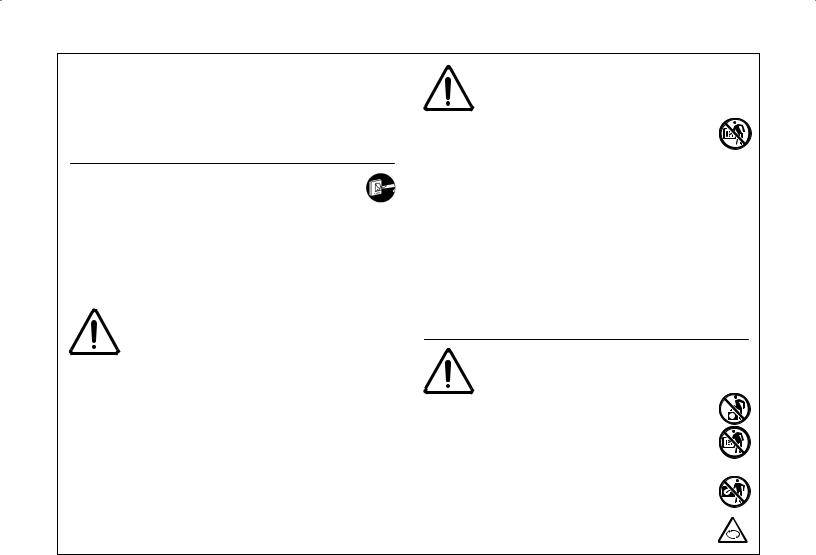
•Do not leak refrigerant while piping work for an installation or re-installation, and while repairing refrigeration parts.
Handle liquid refrigerant carefully as it may cause frostbite.
When Servicing
•Turn the power OFF at the main power box (mains) before opening the unit to check or repair electrical parts and wiring.
•Keep your fingers and clothing away from any moving parts.
•Clean up the site after you finish, remembering to check that no metal scraps or bits of wiring have been left inside the unit being serviced.
WARNING
•This product must not be modified or disassembled under any circumstances. Modified or disassembled unit may cause fire, electric shock or injury.
•Do not clean inside the indoor and outdoor units by users. Engage authorized dealer or specialist for cleaning.
•In case of malfunction of this appliance, do not repair by yourself. Contact to the sales dealer or service dealer for a repair.
CAUTION
• Do not touch the air inlet or the sharp aluminum fins of the outdoor unit. You may get injured.
•Ventilate any enclosed areas when installing or testing the refrigeration system. Escaped refrigerant gas, on contact with fire or heat, can produce dangerously toxic gas.
•Confirm after installation that no refrigerant gas is leaking. If the gas comes in contact with a burning stove, gas water heater, electric room heater or other heat source, it can cause the generation of poisonous gas.
Others
CAUTION
• Do not sit or step on the unit, you may fall down accidentally.
• Do not touch the air inlet or the sharp aluminum fins of the outdoor unit. You may get injured.
• Do not stick any object into the FAN CASE.
You may be injured and the unit may be damaged.
Check of Density Limit
The room in which the air conditioner is to be installed requires a design that in the event of refrigerant gas leaking out, its density will not exceed a set limit.
The refrigerant (R410A), which is used in the air conditioner, is safe, without the toxicity or combustibility of ammonia, and is not restricted by laws imposed to protect the ozone layer. However, since it contains more than air, it poses the risk of suffocation if its density should rise excessively. Suffocation from leakage of refrigerant is almost non-existent. With the recent increase in the number of high density buildings, however, the installation of multi air conditioner systems is on the increase because of the need for effective use of floor space, individual control, energy conservation by curtailing heat and carrying power, etc.
Most importantly, the multi air conditioner system is able to replenish a large amount of refrigerant compared to conventional individual air conditioners. If a single unit of the multi air conditioner system is to be installed in a small room, select a suitable model and installation procedure so that if the refrigerant accidentally leaks out, its density does not reach the limit (and in the event of an emergency, measures can be made before injury can occur).
ASHRAE and the International Mechanical Code of the ICC as well as CSA provide guidance and define safeguards related to the use of refrigerants, all of which define a Refrigerant Concentration Level (RCL) of
25 pounds (11.3 kg) per 1,000 cubic feet (28.3 m3) for R410A refrigerant.
For additional guidance and precautions related to refrigerant safety, please refer to the following documents:
International Mechanical Code 2012 (IMC-2012) (or more recently revised)
ASHRAE 15
ASHRAE 34
3

CONTENTS
Page
IMPORTANT! . . . . . . . . . . . . . . . . . . . 2
Please Read Before Starting
1.General. . . . . . . . . . . . . . . . . . . 5
1-1. Tools Required for Installation (not supplied)
1-2. Accessories Supplied with Unit
1-3. Type of Copper Tube and Insulation Material 1-4. Additional Materials Required for Installation
2.Selecting the Installation Site. . . . . . . .6
2-1. Indoor Unit
3.HOW TO INSTALL THE INDOOR UNIT . . . . . . . .7
3-1. Starting the Installation
3-2. How to Fix Installation Plate
3-3. To Drill a Hole in the Wall and Install a Piping sleeve 3-4. Install the Rear Panel on the Wall
3-5. How to take out Front Grille
3-6. Indoor Unit Installation
3-7. Replace the Drain Hose
3-8. Drain Hose Adapter (supplied) Usage
3-9. Check the Drainage
4. ELECTRICAL WIRING. . . . . . . . . . . . . .12
4-1. General Precautions on Wiring
4-2. Recommended Wire Length and Wire Diameter for Power Supply System
4-3. Wiring System Diagram
■For stranded wiring
■Wiring sample
5.How to Process Tubing. . . . . . . . . . . 16
5-1. Connecting the Refrigerant Tubing
5-2. Connecting Tubing Between Indoor and Outdoor Units
5-3. Insulating the Refrigerant Tubing
5-4. Taping the Tubes
5-5. Finishing the Installation
Page
6. PRECAUTIONS ON TEST RUN. . . . . . . . . . 19
7.HOW TO INSTALL TIMER REMOTE CONTROLLER (CZ-RTC2) OR HIGH-SPEC WIRED REMOTE CONTROLLER (CZ-RTC3) (OPTIONAL PART). . . . 19
NOTE
Refer to the Operating Instructions attached to the optional Timer Remote Controller or optional High-spec Wired Remote Controller.
8. APPENDIX . . . . . . . . . . . . . . . . . . 20
■When Using Wireless Remote Controller Instead of Wired Remote Controller
■Troubleshooting
■Tips for Energy Saving
4
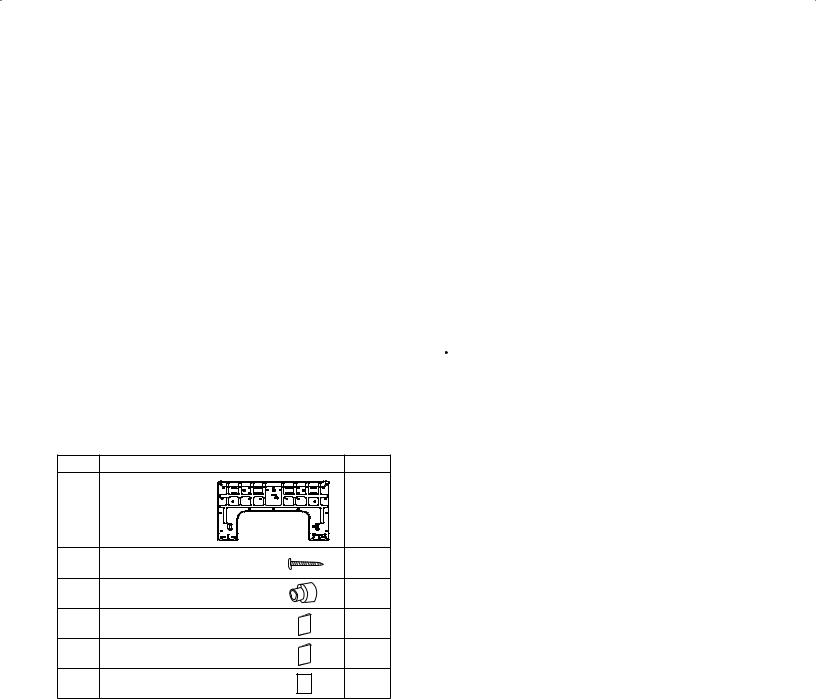
1. General
This booklet briefly outlines where and how to install the air conditioning system. Please read over the entire set of instructions for the indoor units and make sure all accessory parts listed are with the indoor units before beginning.
1-1. Tools Required for Installation (not supplied)
1.Flathead screwdriver
2.Phillips head screwdriver
3.Knife or wire stripper
4.Tape measure
5.Carpenter’s level
6.Sabre saw or keyhole saw
7.Hacksaw
8.Core bits
9.Hammer
10.Drill
11.Tube cutter
12.Tube flaring tool
13.Torque wrench
14.Adjustable wrench
15.Reamer (for deburring)
1-2. Accessories Supplied with Unit
Wall Mounted (K2 type)
No. |
Accessories part |
Qty. |
1 |
Installation plate |
1 |
2 |
Installation plate fixing screw |
5 |
3 |
Drain hose adapter |
1 |
4 |
Operating Instructions |
1 |
5 |
Installation Instruction |
1 |
6 |
Warranty card |
1 |
1-3. Type of Copper Tube and Insulation Material
If you wish to purchase these materials separately from a local source, you will need:
1.Deoxidized annealed copper tube for refrigerant tubing. Cut each tube to the appropriate lengths +1 ft. (30 cm) to 1.5 ft. (40 cm) to dampen vibration between units.
2.Foamed polyethylene insulation for copper tubes as required to precise length of tubing. Wall thickness of the insulation should be not less than 5/16” (8 mm).
3.Use insulated copper wire for field wiring. Wire size varies with the total length of wiring.
Refer to 4. ELECTRICAL WIRING for details.
 CAUTION
CAUTION
Check local electrical codes and regulations before obtaining wire. Also, check any specified instructions or limitations.
1-4. Additional Materials Required for Installation
1.Refrigeration (armored) tape
2.Insulated staples or clamps for connecting wire (See your local codes.)
3.Putty
4.Refrigeration tubing lubricant
5.Clamps or saddles to secure refrigerant tubing
6.Scale for weighing
5
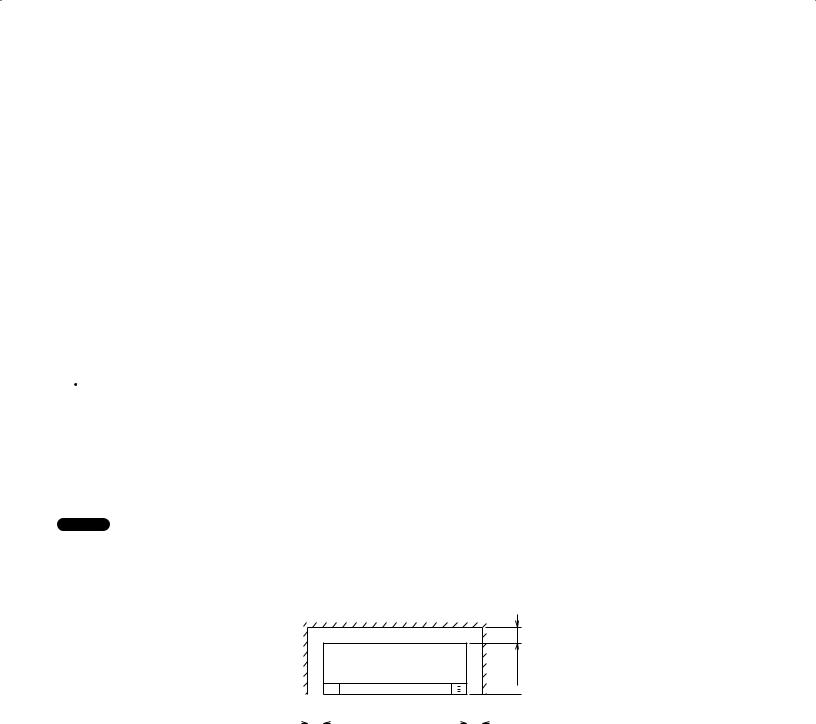
2. Selecting the Installation Site
2-1. Indoor Unit
AVOID:
●areas where leakage of flammable gas may be expected.
●places where large amounts of oil mist exist.
●direct sunlight.
●locations near heat sources which may affect the performance of the unit.
●locations where external air may enter the room directly.
This may cause “condensation” on the air discharge ports, causing them to spray or drip water.
●locations where the remote controller will be splashed with water or affected by dampness or humidity.
●installing the remote controller behind curtains or furniture.
●locations where high-frequency emissions are generated.
DO:
●select an appropriate position from which every corner of the room can be uniformly cooled.
●select a location where the ceiling is strong enough to support the weight of the unit.
 WARNING
WARNING
●select a location which can support a load that is four times the indoor unit weight.
●select a location where tubing and drain pipe have the shortest run to the outdoor unit.
●allow room for operation and maintenance as well as unrestricted air flow around the unit.
●install the unit within the maximum elevation difference above or below the outdoor unit and within a total tubing length (L) from the outdoor unit as detailed in the installation instructions packed with the outdoor unit.
●allow room for mounting the remote controller about 3.3 ft. (1 m) off the floor, in an area that is not in direct sunlight nor in the flow of cool air from the indoor unit.
NOTE
Air delivery will be degraded if the distance from the floor to the ceiling is greater than 9.8 ft. (3 m).
The air inlet and outlet of the indoor unit must be free of any obstructions to allow air to spread throughout the room.
1.The indoor unit must be within a maintenance space.
Unit: inch (mm)
-9/16 (65) |
or more |
2 |
|
4 (100) or more |
|
|
|
2 (50) or more |
|
|
|
|
|
|
|
|
|
Front View
Fig. 2-1
6
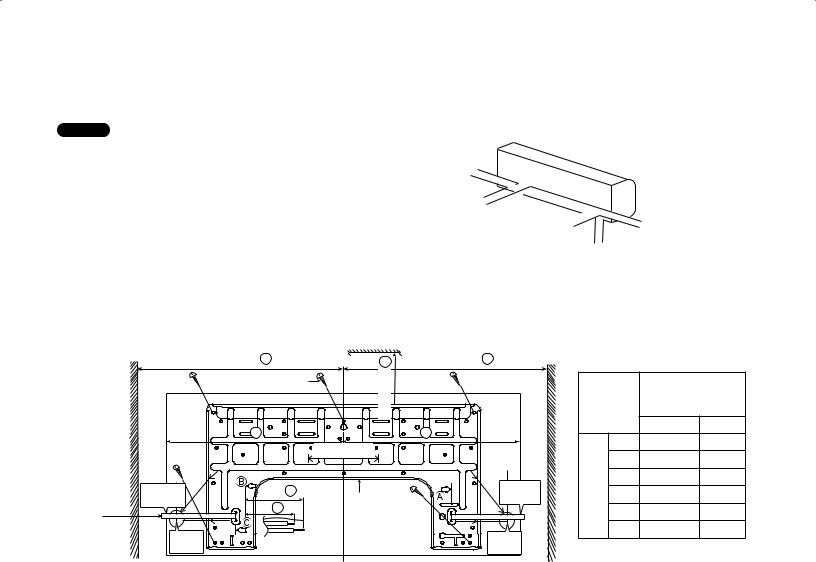
3. HOW TO INSTALL THE INDOOR UNIT
3-1. Starting the Installation
(1) Remove the rear panel.
NOTE
Tubing can be extended in 6 directions as shown in Fig. 3-1. Select the direction you need providing the shortest run to the outside unit.
3-2. How to Fix Installation Plate
Piping direction
(Front side)
Right
Right Rear 
Right bottom Left Left
Rear
Left bottom
Fig. 3-1
The mounting wall should be strong and solid enough to withstand the unit’s vibration.
|
|
|
|
|
Unit: inch (mm) |
|
|
|
|
|
Wall |
|
More than |
|
Wall |
|
Wall |
|
|
|
|
|
|
1 |
2 |
More than |
1 |
Table 3-1 |
|
|
||
|
|
|
2 screw |
than |
|
|
|
|
S-07MK2U6 |
|
|
|
|
|
|
|
|
|
|||
|
|
|
|
More |
|
|
|
|
S-09MK2U6 |
|
|
|
|
|
|
|
|
|
S-12MK2U6 |
||
|
|
|
|
|
|
|
|
|
||
|
|
3 |
|
|
4 |
|
|
|
inch |
mm |
|
|
|
|
|
|
1 |
21-17/64 |
540 |
||
|
|
|
|
5-3/64 (128) |
|
|
|
|||
|
|
|
|
|
|
|
2 |
3-15/64 |
82 |
|
Measuring |
(241.5) |
|
5 |
|
|
|
Dimension |
|||
PIPE HOLE CENTER |
|
DISTANCE TO |
|
3 |
17-9/32 |
439 |
||||
|
|
|
|
|
CENTER 128 mm |
|
|
|||
|
|
|
|
|
PIPE HOLE |
9-33/64 |
|
|
|
|
|
9-33/64 |
|
6 |
|
|
|
4 |
17-1/64 |
432 |
|
|
|
|
|
Installation |
|
(241.5) |
|
|||
Tape |
|
|
|
plate 1 |
|
|
|
5 |
1-11/16 |
43 |
|
|
DISTANCE |
|
|
PIPE HOLE |
|
|
6 |
3-47/64 |
95 |
|
|
CENTER |
|
|
CENTER |
|
|
|||
|
5-3/64 |
TO PIPE |
|
|
5-3/64 |
|
|
|
||
|
128 mm |
|
|
|
|
|
|
|||
|
|
HOLE |
|
|
|
|
|
|
|
|
|
(128) |
|
|
|
|
(128) |
|
|
|
|
|
|
|
|
|
|
Fig. 3-2 |
|
|
|
|
The center of installation plate should be at more than 1 at right and left of the wall.
The distance from installation plate edge to ceiling should be more than 2.
From installation plate center to unit’s left side is 3.
From installation plate center to unit’s right side is 4.
For left side piping, piping connection for liquid should be about 5 from this line.
For left side piping, piping connection for gas should be about 6 from this line.
(1)Mount the installation plate on the wall with 5 screws or more (at least 5 screws). (If mounting the unit on the concrete wall, consider using anchor bolts.)
●Always mount the installation plate horizontally by aligning the marking-off line with the thread and using a level gauge.
(2)Drill the piping plate hole with ø2-3/4” (ø70 mm) hole-core drill.
●Putting measuring tape at position as shown in the diagram above.
The hole center is obtained by measuring the distance namely 5-3/64” (128 mm) for left and right hole respectively. Another method is intersection point of arrow mark extension.
The meeting point of the extension arrow mark is the hole center position.
●Drill the piping hole at either the right or the left and the hole should be slightly slanting to the outdoor side. (Refer to Section 3-3. “To Drill a Hole in the Wall and Install a Piping sleeve”.)
7
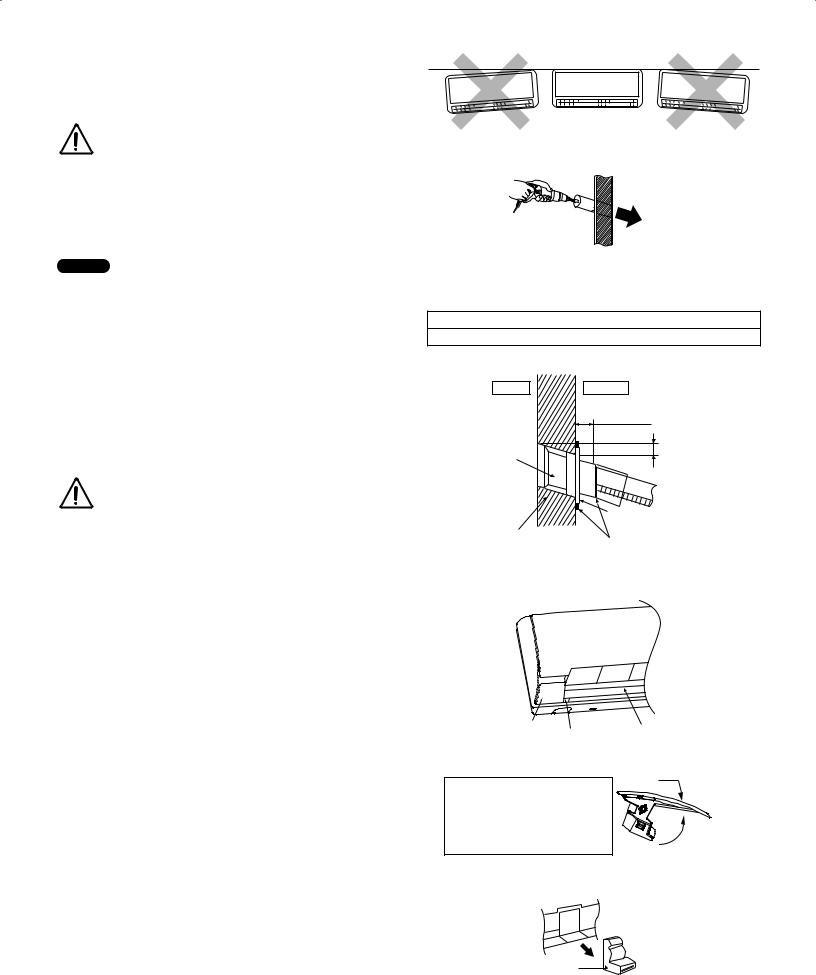
(3)Double check with a carpenter’s level or tape measure that the panel is level. This is important to install the unit properly. (Fig. 3-3)
CAUTION |
Also avoid areas where electrical |
wiring or conduits are located. |
The previous precautions are also applicable if tubing goes through the wall in any other location.
(4)Using a sabre saw, keyhole saw or hole-cutting drill attachment, cut a hole in the wall. (Fig. 3-4)
NOTE
Hole should be made at a slight downward slant to the outdoor side.
3-3. To Drill a Hole in the Wall and Install a Piping sleeve
(1)Insert the piping sleeve to the hole.
(2)Fix the bushing to the sleeve.
(3)Cut the sleeve until it extrudes about 5/8” (15 mm) from the wall.
When the wall is hollow, please be sure
to use the piping sleeve assembly to CAUTION prevent dangers caused by mice biting
the connection cable.
(4)Finish by sealing the sleeve with putty or caulking compound at the final stage.
3-4. Install the Rear Panel on the Wall
Be sure to confirm that the wall is strong enough to suspend the unit.
(1)Make sure the panel is flush against the wall.
Any space between the wall and unit will cause noise and vibration.
3-5. How to take out Front Grille
Please follow the steps below to take out front grille if necessary such as when servicing.
(1)Set the vertical airflow direction louvers to the horizontal position.
(2)Remove the 2 caps on the front grille as shown in the figure at right, and then remove the 2 mounting screws.
(3)Pull the lower section of the front grille towards you to remove the front grille.
Fig. 3-3
Indoor |
Outoor |
side |
side |
|
Fig. 3-4 |
Table 3-2 |
|
|
Hole Diameter |
|
2-3/4 inch (70 mm) |
|
Wall |
Indoor |
Outdoor |
|
5/8” (15 mm) |
Sleeve for tube |
|
assembly |
Approx. 1/4” (5 - 7 mm) |
|
|
|
Bushing for tube |
ø2-3/4” (ø70 mm) |
Assembly |
|
|
through hole |
Putty or caulking compound |
Fig. 3-5
Front grille
Cap
When reinstalling the front grille, first set the vertical airflow direction louver to the horizontal position and then carry out steps
(2) - (3) described at left in the reverse order.
Vane
Fig. 3-6
Vane
(Move the vane to upward)
Fig. 3-7


 Screw
Screw
Cap
Fig. 3-8
8
